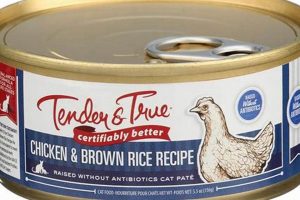Dietary formulations designed to minimize the magnesium content are specifically crafted for felines. These specialized foods aim to restrict the intake of a particular mineral, often measured in parts per million (ppm) or as a percentage of dry matter in the food. For example, a product labeled as having controlled mineral levels may contain less than 0.1% magnesium on a dry matter basis.
The significance of controlling mineral levels lies primarily in supporting urinary tract health. Historically, elevated levels of certain minerals in feline diets have been associated with the formation of crystals in the urine, potentially leading to discomfort and even urinary obstruction. Formulations restricting these components are intended to mitigate these risks, thus promoting better well-being in susceptible animals.
Understanding the specific needs of felines regarding mineral intake is crucial. The following sections will delve into the rationale behind mineral-restricted diets, the associated health implications, and how to choose appropriate nutritional options for cats with specific dietary requirements.
Considerations for Mineral-Restricted Feline Diets
The following guidelines offer insights into the proper selection and utilization of mineral-controlled food options for cats.
Tip 1: Consult a Veterinary Professional: Prior to implementing a mineral-restricted diet, seek guidance from a veterinarian. A proper diagnosis is essential to determine if this dietary approach is appropriate for the feline’s specific health condition.
Tip 2: Review Product Labels Carefully: Scrutinize product labels to verify the magnesium content. Compare the listed values to the recommendations provided by the veterinarian. Pay close attention to whether the values are presented on an “as fed” or “dry matter” basis.
Tip 3: Adhere to Feeding Guidelines: Follow the feeding guidelines provided by the manufacturer. Avoid overfeeding, as this can negate the benefits of a controlled mineral content. Measure portions accurately.
Tip 4: Ensure Adequate Hydration: Promote water consumption. Increased water intake helps dilute urine, which can further assist in preventing the formation of urinary crystals. Consider providing multiple water sources, including fresh water and wet food options.
Tip 5: Monitor Urinary pH: Work with the veterinarian to regularly monitor the feline’s urinary pH levels. This monitoring helps to assess the effectiveness of the diet and make adjustments as needed.
Tip 6: Transition Diets Gradually: When introducing a new diet, do so gradually over a period of several days. This gradual transition helps to minimize digestive upset and ensures the feline accepts the new food.
Tip 7: Avoid Supplementation Without Veterinary Approval: Refrain from administering any mineral or vitamin supplements unless explicitly instructed by a veterinarian. Supplementation can disrupt the carefully balanced mineral content of the restricted diet.
Adherence to these tips, under the direction of a veterinarian, can maximize the potential benefits and promote the health and well-being of felines requiring specific dietary modifications.
The succeeding sections will further clarify the importance of continuous monitoring and the overall management strategies for felines with specific nutritional requirements.
1. Urinary Crystal Prevention
Urinary crystal formation in felines is frequently linked to the mineral composition of their diet, with magnesium playing a significant role. Elevated levels of this mineral in urine can contribute to the precipitation of struvite crystals, a common cause of feline lower urinary tract disease (FLUTD). Dietary formulations specifically restricting magnesium are designed to address this issue by reducing the concentration of magnesium available for crystal formation within the urinary tract. The intention is to maintain a urinary environment less conducive to crystal development, thereby mitigating the risk of urinary blockages and associated discomfort.
Real-world examples illustrate the practical significance of this dietary approach. Cats diagnosed with recurrent struvite crystalluria often experience significant improvement when switched to a diet with reduced magnesium content. Furthermore, prophylactic use of these diets can be implemented in felines with a history of urinary issues or those identified as being at higher risk. However, it is vital to recognize that crystal formation can also be influenced by other factors, such as urinary pH and water intake. Therefore, a multi-faceted approach, incorporating dietary adjustments, adequate hydration, and veterinary oversight, is generally recommended.
In summary, mineral-restricted feline food, especially with controlled magnesium levels, is a vital tool in preventing urinary crystal formation. While it constitutes an important aspect of managing feline urinary health, it should be viewed as one component of a broader, veterinarian-guided strategy that includes addressing other contributing factors. Successful implementation necessitates careful consideration of product formulations, diligent monitoring, and adherence to veterinary recommendations.
2. Dietary Mineral Control
Dietary mineral control is fundamental to the rationale behind specialized feline nutritional products. The formulation of these products, particularly those designed to limit magnesium content, is predicated on the understanding that dietary intake directly influences mineral concentrations within the feline’s body, including the urinary tract. Elevated levels of specific minerals, such as magnesium, can contribute to the supersaturation of urine, increasing the likelihood of crystal formation. Therefore, restricting dietary intake is a primary mechanism for managing mineral levels in the urinary system and mitigating the risk of urolithiasis. A controlled magnesium level is a deliberate design feature, directly linking dietary input to physiological outcome.
Consider the instance of a feline exhibiting recurrent struvite crystalluria. A conventional diet may provide sufficient magnesium to exacerbate crystal formation. By transitioning to a product meticulously formulated to limit this specific mineral, the dietary input is directly manipulated to reduce urinary magnesium concentration. This illustrates the application of dietary mineral control in a practical scenario. The effect, when successful, manifests as a reduction in crystal formation, diminished urinary tract inflammation, and alleviated clinical signs, such as dysuria or hematuria. Success requires consistent feeding of the controlled diet, underscoring the ongoing relationship between dietary intake and physiological effect.
In summary, dietary mineral control, as embodied by carefully formulated feline nutritional products, represents a proactive approach to managing mineral concentrations within the feline’s system. The link between dietary input and physiological outcome is direct and underscores the importance of meticulous formulation and consistent feeding practices. While not a standalone solution for all urinary tract issues, restricted diets are a valuable tool in managing mineral-related conditions, provided they are implemented under the guidance of a veterinary professional, and in conjunction with a comprehensive management plan.
3. Veterinary Consultation Crucial
The implementation of a feline diet with controlled magnesium content necessitates a veterinary consultation. This requirement stems from the potential for misdiagnosis and the variability in underlying causes of feline lower urinary tract signs (FLUTS). While elevated urinary magnesium can contribute to struvite crystal formation, other factors, such as urinary pH, calcium phosphate crystals, or idiopathic cystitis, may also be implicated. A veterinary examination and diagnostic testing, including urinalysis and potentially imaging, are essential to identify the specific etiology of the cat’s clinical signs. Employing a restricted magnesium diet without a confirmed diagnosis may be ineffective or even detrimental if the primary problem is unrelated to magnesium levels. Real-world scenarios illustrate this point; a cat with calcium oxalate crystals will not benefit from mineral restriction, potentially delaying appropriate treatment and worsening its condition.
Furthermore, a veterinarian can assess the feline’s overall health and identify any contraindications to mineral-restricted diets. Some medical conditions may require careful consideration when modifying a cat’s nutritional intake. The veterinarian provides guidance on appropriate dietary selection based on the feline’s individual needs, monitoring its response to the diet, and making adjustments as necessary. Monitoring includes follow-up urinalysis to assess urinary pH and crystal formation, enabling the veterinarian to fine-tune the dietary approach and ensure optimal outcomes. Absent this monitoring, sub-optimal urinary conditions, or even the formation of different crystal types, can go undetected.
In conclusion, veterinary consultation constitutes a critical component of utilizing a diet with controlled magnesium. It ensures accurate diagnosis, prevents inappropriate dietary modifications, enables individualized treatment plans, and facilitates ongoing monitoring to optimize feline urinary health. Circumventing this crucial step poses a risk to the cat’s well-being and could potentially exacerbate the underlying condition. A professional evaluation is mandatory for the safe and effective implementation of any significant dietary alteration.
4. Label Analysis Required
The correlation between label analysis and controlled mineral content diets is direct and consequential. The efficacy of such diets hinges entirely on the accuracy of the information declared on the product packaging. A diet intended to limit mineral intake, specifically magnesium, can only achieve its objective if the stated magnesium content is both accurate and low enough to effect the desired physiological change in the feline. Real-world examples demonstrate the importance of label verification. For instance, an owner relying on a product marketed as magnesium-controlled may inadvertently select a product with deceptively high magnesium levels if the label is unclear or contains misleading information. This negates any potential benefit and may exacerbate existing urinary issues.
Further, mineral content is typically expressed as a percentage on a dry matter basis. Comparing multiple products requires understanding this terminology. The “dry matter” designation represents the nutrient concentration after all water has been removed, allowing for an equitable comparison between wet and dry formulations. An inexperienced owner may mistakenly compare the “as-fed” percentage from a wet food label to the “dry matter” percentage of a dry food, leading to inaccurate assessments of the true mineral content. A lack of clarity or transparency on product labels can render the diet ineffective, potentially misleading owners and hindering appropriate dietary choices. Regulatory oversight plays a crucial role in ensuring label accuracy, but consumers must also be educated to interpret these values correctly.
In summary, label analysis is not merely a supplementary step but an indispensable component of controlled-mineral feline diets. The precision of this assessment determines the diet’s actual composition and, consequently, its potential to achieve the intended therapeutic outcome. Owners should understand the significance of dry matter analysis and actively scrutinize product labels before implementing these diets. The absence of accurate information undermines the entire premise of dietary management, potentially jeopardizing the feline’s health.
5. Hydration Essential Component
The interplay between water intake and magnesium-restricted feline diets is crucial for optimizing urinary health. Adequate hydration dilutes urine, reducing the concentration of minerals, including magnesium, and other potential irritants. This dilution minimizes the likelihood of crystal formation, a common concern in felines predisposed to urinary tract issues. Real-world examples highlight this relationship: a cat consuming a diet with controlled mineral levels may still develop crystals if water intake is insufficient, as the urine becomes overly concentrated, surpassing the saturation point for crystal precipitation.
The practical application of this understanding involves several strategies to encourage water consumption. Providing multiple fresh water sources, utilizing palatable water bowls, and offering wet food options can all increase fluid intake. Canned food, with its high water content, contributes significantly to daily hydration needs, complementing the controlled mineral composition of the diet. Conversely, limiting water access or feeding primarily dry food without adequate water supplementation can negate the benefits of a carefully formulated diet. The effectiveness of mineral restriction hinges on the concurrent maintenance of sufficient urine volume through increased water consumption.
In conclusion, sufficient hydration is an indispensable element in managing feline urinary health, particularly when utilizing mineral-restricted diets. While controlling mineral intake aims to reduce the availability of crystal-forming substances, adequate water intake serves to dilute their concentration, further mitigating the risk of urinary issues. This multifaceted approach, combining dietary modification and hydration strategies, requires diligent monitoring and often the guidance of a veterinary professional, ensuring optimal feline urinary tract function.
Frequently Asked Questions About Mineral-Restricted Feline Diets
The following addresses common inquiries regarding dietary formulations designed to limit magnesium content in feline nutrition.
Question 1: What is the primary purpose of diets restricting magnesium levels in feline nutrition?
The primary purpose is to reduce the risk of struvite crystal formation in the urinary tract. Elevated urinary magnesium concentrations can contribute to crystal precipitation, potentially leading to urinary blockages and discomfort.
Question 2: Are mineral-restricted diets appropriate for all felines?
No, these diets are not universally appropriate. They are generally recommended for felines diagnosed with, or predisposed to, struvite crystalluria. A veterinarian must determine the appropriateness of this dietary approach based on an individual cat’s health status.
Question 3: How is the magnesium content typically expressed on product labels?
Magnesium content is typically expressed as a percentage on a dry matter basis. This represents the concentration after water removal and allows for comparing wet and dry formulations. Reading labels carefully is essential.
Question 4: Can other minerals besides magnesium influence urinary crystal formation?
Yes, other minerals, such as phosphorus and calcium, and other factors, such as urinary pH, can play a role in crystal formation. A comprehensive assessment is required to determine the underlying causes.
Question 5: Is it necessary to monitor a feline while it is consuming a mineral-controlled diet?
Ongoing monitoring is essential. Regular urinalysis, conducted by a veterinarian, helps assess the effectiveness of the diet and ensures urinary pH and crystal formation remain within acceptable ranges. Adjustments may be necessary.
Question 6: Can mineral or vitamin supplements be safely administered alongside controlled diets?
Supplements should only be administered under veterinary guidance. Unnecessary supplementation can disrupt the carefully balanced mineral content of the diet and potentially counteract its intended benefits.
Appropriate implementation and veterinary supervision are crucial for achieving optimal results when using diets formulated with mineral restrictions. A thorough understanding of these dietary considerations enables responsible pet ownership and improved feline well-being.
The subsequent section explores practical strategies for transitioning a feline to a restricted diet and maintaining its long-term health.
Conclusion
This exploration has illuminated the significance of diets with controlled mineral content, specifically the role these diets play in supporting feline urinary health. The prudent use of “low magnesium cat food”, under the guidance of a veterinary professional, represents a proactive approach to mitigating the risk of struvite crystal formation. Accurate label interpretation, diligent monitoring, and the promotion of adequate hydration are crucial components of successful dietary management.
The information presented underscores the responsibility of pet owners to prioritize informed decision-making in feline nutrition. Continued research and veterinary oversight are essential for advancing the understanding and application of specialized diets in promoting long-term well-being. The judicious selection and implementation of a “low magnesium cat food” offer a valuable tool in maintaining feline health, but must be viewed as part of a comprehensive strategy that addresses individual needs and potential underlying conditions.







